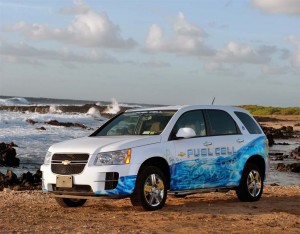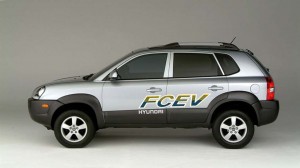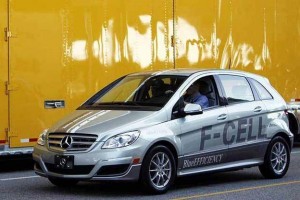Remember the future? It was supposed to be hydrogen-powered. At least that was what energy and auto industry leaders were saying for most of the past decade or so. That was before everyone’s attention turned to lithium-powered battery cars.
Suddenly, hydrogen — and the fuel cell vehicles it was supposed to power — has dropped from the headlines. But not from the highway. Despite the attention being lavished on battery power, these days, and the hefty incentives being ladled out by both Washington and plenty of governments abroad, fuel cell technology is alive and well and still very well could become the truly clean and efficient technology of the future.
Just ask Hyundai or Daimler AG. Both automakers have made it clear they’re not giving up on hydrogen power in recent days.
The Korean maker is broadly hinting that it could bring a hydrogen fuel cell vehicle to the U.S. as early as 2012, a model that it suggests would look like a downsized version of the Mercedes R-Class crossover/van.
That would likely be a test program, but the maker has also said it plans to begin commercial fuel-cell vehicle, or FCV, production by 2015.

GM and its new partners plan to set up a hydrogen fueling network, in Oahu, for vehicles like this Chevrolet Equinox FCV.
In an e-mailed statement, the maker said it would be an upgrade of the prototype Tucson IX, which was first tested in 2008. Significantly, since then, the vehicle’s range has been increased 55%, to a maximum 400 miles, while fuel efficiency has improved 15%, Hyundai claims.
Meanwhile, Daimler’s Mercedes-Benz division has begun leasing its latest FCV, to California residents. Vance Van Petten, the executive director of the Producers Guild of America, took delivery of the first commercially-available Mercedes F-Cell at a dealership in Newport Beach.
The F-Cell is a hydrogen-powered version of the Mercedes B-Class, itself a sort of downsized R-Class crossover. The automaker showed off the new vehicle during a preview earlier this year, revealing that its fuel cell system can produce about 134 horsepower – and nothing but water vapor out of the tailpipe.
Hydrogen can be used in several different ways to power a vehicle. BMW and Mazda have been exploring the use of the gas as an alternative to gasoline, the German maker using a conventional internal combustion engine in its Hydrogen7 prototype, while Mazda has developed a hydrogen-fueled version of its rotary engine, used in a prototype RX8 sports car.
Most makers are focusing on fuel cells, using a device known as a stack to combine the lightweight gas with oxygen from the atmosphere to produce a stream of current that can be used to power electric motors driving a vehicle’s wheels. Effectively, that makes the technology a sort of refillable battery.
Indeed, “all the development knowledge” for Honda’s new battery car program “was leveraged” from its work with fuel cells, Sachito Fujimoto, the maker’s chief engineer for fuel cells and battery cars told the Bloomberg news service, last week. “Fuel cell technology is very difficult,” he said, adding that, “We tried to work on the most difficult technology first.”
Honda is planning to launch a battery-powered version of its subcompact Fit in 2012, but it has been leasing a hydrogen-powered model, the FCX Clarity, for two years in Southern California. There are a number of refueling stations in the region, which is one of the reasons Mercedes is able to begin marketing the F-Cell there.
The German government remains one of the most active proponents of hydrogen power, which many believe will eventually prove the most practical zero-emissions technology. Earlier this year, Berlin authorized plans to set up a network of more than 1,000 hydrogen refueling stations around the country, though many will also be equipped with battery chargers, as well.
The U.S. government has backed off, a bit, from its earlier support of hydrogen power, however.
“We asked ourselves, ‘Is it likely in the next 10 or 15, 20 years that we will covert to a hydrogen car economy?’ The answer, we felt, was ‘no,’” Steven Chu, Secretary of the Dept. of Energy, said in May 2009.
Washington has since diverted hundreds of millions of dollars originally earmarked for hydrogen research to help fund battery and battery vehicle development.
While proponents note that fuel cell technology is showing huge improvements – the latest GM fuel cell stack is barely half the size of the prior generation, cheaper and significantly more powerful — opponents contend hydrogen isn’t even close to ready for prime time.
The challenges, even supporters agree, are numerous. There’s the issue of producing the gas; while it’s the most common element in the universe, hydrogen must be separated from some other source, such as coal, natural gas or water, itself an energy-intensive process. Distributing the gas is a challenge. And storing hydrogen is costly and also quite difficult.
Nonetheless, it can overcome the range limitations of battery power. And, in the right locations, producing hydrogen is clean and effective.
That’s why the State of Hawaii has just announced an expansive program that partners General Motors with a dozen other corporations and universities to create a hydrogen distribution network on the state’s most populous island, Oahu. (For the complete story, Click Here.)
By 2015, the Hawaii Hydrogen Initiative, or H2I, plans to have as many as 25 pumps operating around Oahu, with GM selling a hydrogen vehicle – most likely a special version of its Chevrolet Equinox crossover.
Other makers, including Ford, say they will continue working on hydrogen power, as well, but considering the global push for battery technology, the once wide-eyed goal of making hydrogen a serious alternative to gasoline over the next decade seems far, far over-ambitious.


